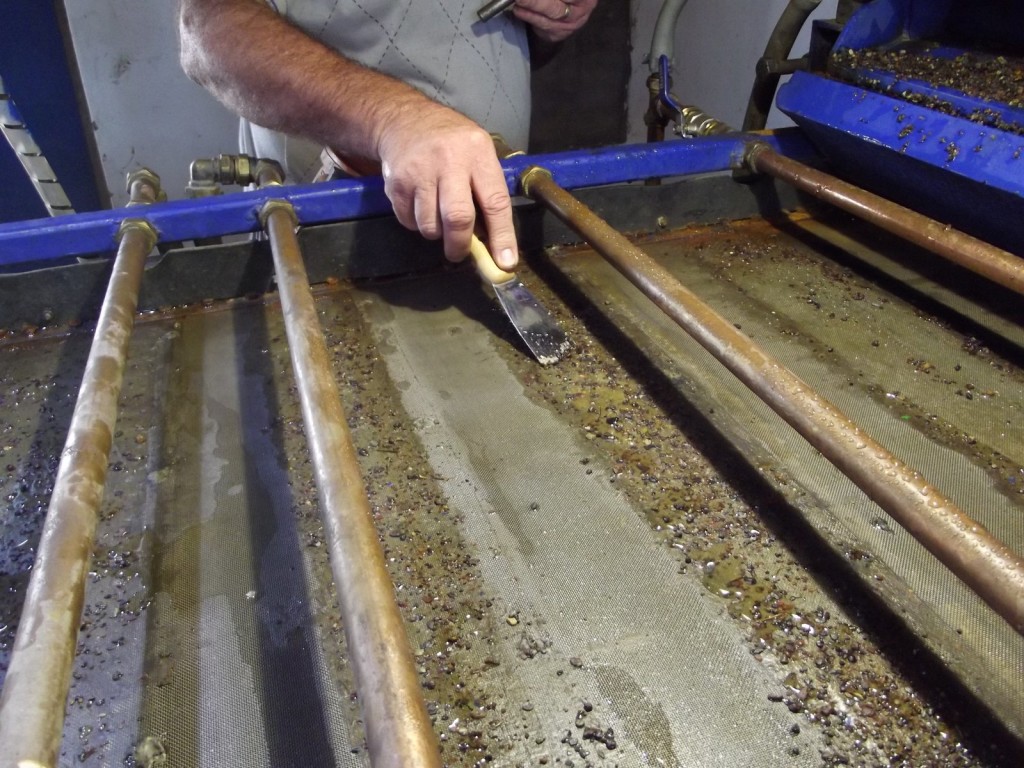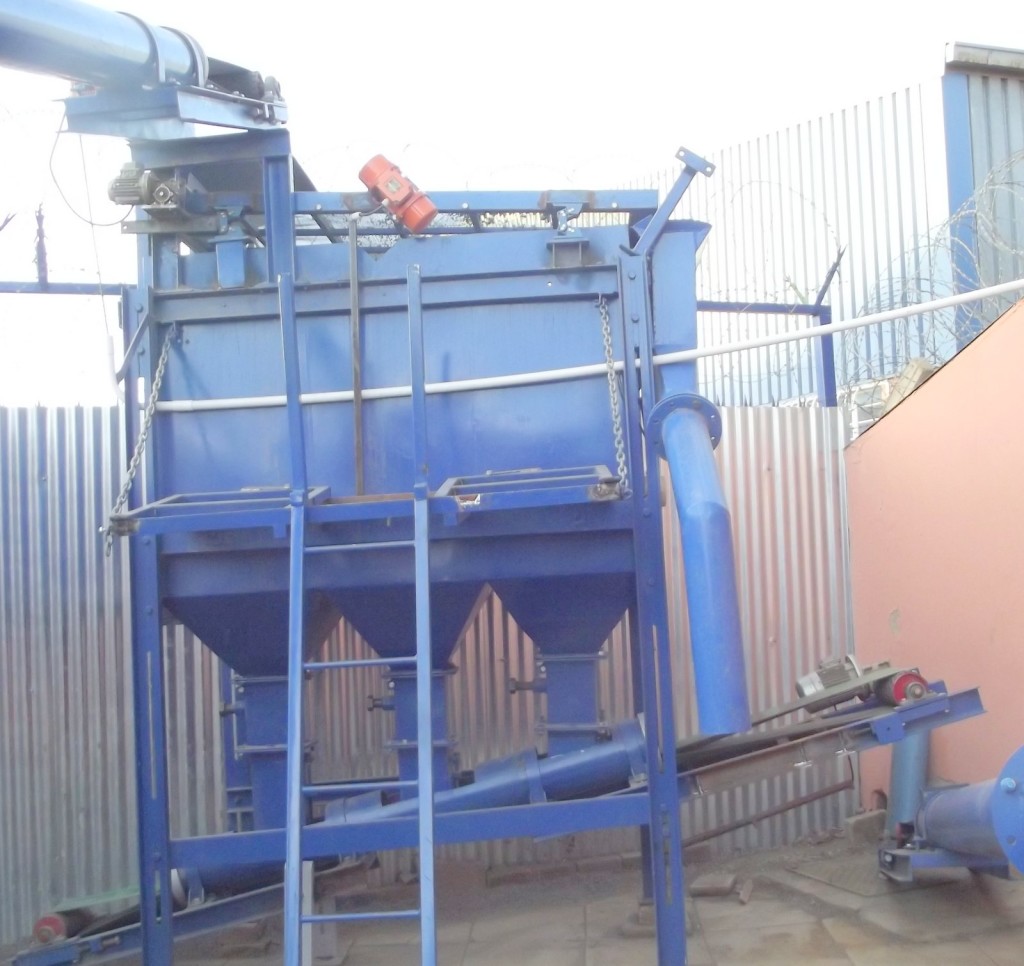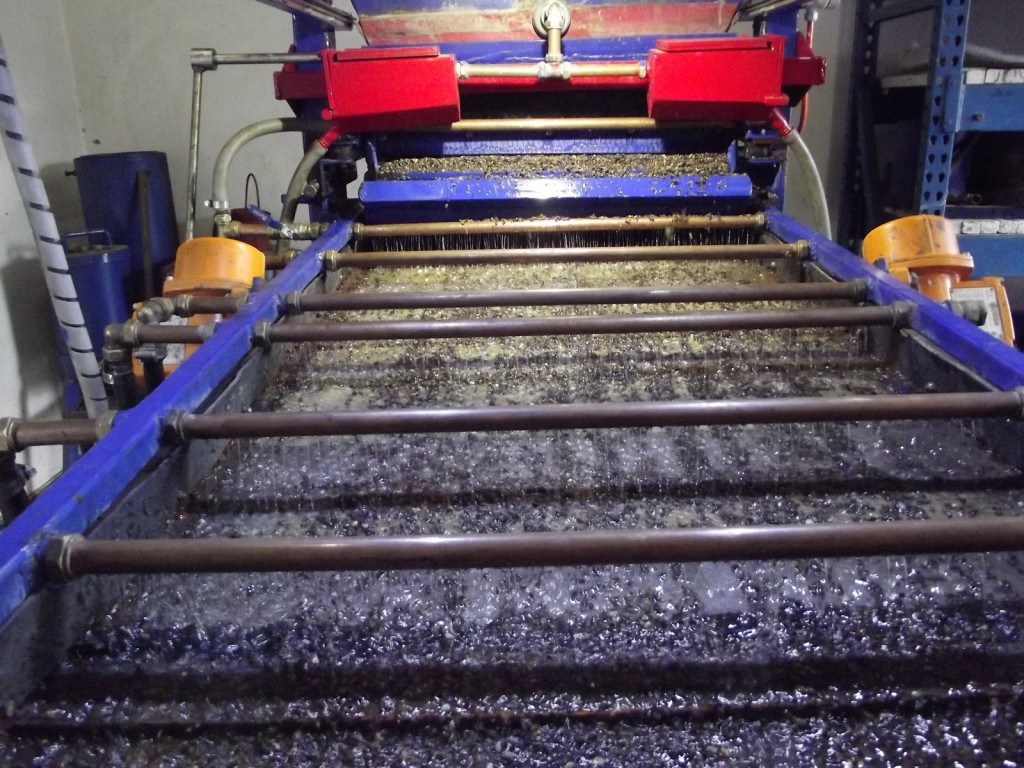
Diamond Grease Recovery Equipment
Gondwanaland Diamonds SA (Pty) Ltd
Tel: +27 53 832 5143
Email: katearms@gmail.com

A. SUMMARY OF REQUIREMENTS
The following factors are of prime importance for the efficient recovery of diamonds from diamond bearing concentrates when using grease recovery:
- Grease quality and usage
- Spray water
- Sizing of material
- Scrubbing of concentrates
- Feeding of material
- Security
- Plant configuration
B. DETAILED DISCUSSION
The following is a detailed discussion concerning the above 7 requirements.
Each point discussed is followed by a description in italics as to how Gondwanaland Diamonds SA grease recovery equipment complies with these requirements.
1. Grease quality and usage
Only good quality grease from a reliable supplier should be used where each production batch has been tested with selected diamonds to confirm efficient diamond recovery.
The diamond grease supplied and used by Gondwanaland Diamonds SA (Pty) Ltd is diamond tested before use and sale, and can only be guaranteed provided the following requirements 2 to 6 are adhered to.
Where the diamond grease is to be recovered by heating and reused after initial usage, the recovered grease must be reconstituted by melting and dissolving 10% of virgin grease into the used grease. This is necessary to compensate for the volatiles lost during the initial heating and melting process in the grease recovery.
The grease is applied through the 0.5mm screen cloth from underneath the screen see photo 4. The grease is scraped off the grease table with a spatula and deposited into one of the two grease recovery boxes which are situated within the glove box at the material entry end of the grease screen. Photos 2,3



The steam produced by the steam generator is introduced into the grease box and melts the grease which flows through the contained 0.4mm mesh wire basket and exits the grease box and the glove box through a rubber tube. This grease is collected in a grease pot which is then transferred to a suitable water heated urn where the grease is remelted and 10% virgin grease is added to compensate for and volatiles lost during the previous melting. The recovered grease is now ready for reuse. Photos 5, 6, 7 & 8




2. Spray Water
The grease vibratory screen spray water must be clean and preferably contain less than 100 ppm of solids. Excess solids in the water will collect on the grease surface and detract from its effectiveness.
The spray water is continuously circulated through a sand filter to remove and prevent any build up of solids. Photo 9

It is important that the spray water applied to the screen must be at the right temperature so as to maintain a temperature of ideally between 19 and 22°C. Below 18°C diamond loss will occur and above 22°C any foreign material and gaunge will start sticking to the grease and foul the grease surface.
The temperature of the grease on our vibrating grease table is controlled by working in an air conditioned environment and by using temperature controlled spray water. Our equipment will only start and continue functioning if the water temperatures within the above limits 19 to 22°C. The water temperature is controlled by an electric element in the water reservoir and a water chilling unit, both of which are controlled electrically through a temperature control unit. The settings on this unit are altered where necessary to maintain the grease surface temperature within the above temperature range which is measured at the grease surface with a lazer temperature measuring instrument. All equipment will automatically switch off if the spray water is not at the correct temperature. Photo 10

3. Sizing of material
The material fed over the grease must be correctly sized into size fractions not greater than 0.5 to 1.0 mm, 1.0 to 2.0 mm, 2.0 to 4 mm, 4 to 8 mm etc. This is so that the largest particle being fed will not dislodge a smaller diamond which is already stuck to the grease. Larger non diamond particles outside the above size range may also knock diamonds already stuck to the grease right into the grease if the grease is too soft or the grease layer is too thick.
We have sizing screens that accurately and efficiently screen into the above size fractions. Photos 11 & 12 See our website on vibratory screens. We use a grease layer of 1 to 2 mm thick which is more than adequate and saves on grease consumption. Our grease is applied from outside the glove box through the drum tight 0 – 4 mm screen of the vibrating grease table to produce a grease thickness of 1.0 to 2.0 mm on the screen surface. Photo 4


4. Scrubbing of Material
It is essential to scrub the material immediately before feeding it over the grease table. Diamonds can be coated to a greater or lesser degree with an atomic, molecular, or a more significant coating which will effect their hydrophobic nature and influence their sticking to the grease. A scrubber residence time of 12 minutes is recommended but longer scrubbing may be required. It must be pointed out that diamonds from different deposits or even within the same deposit can have different hydrophobic properties and scrubbing will only enhance the hydrophobic nature of the diamonds.
We provide a scrubber which is situated immediately above the grease table and glove box. The scrubber is fitted with a variable speed drive to vary its speed of rotation and a switch to alter the direction of rotation. A helical spiral is fitted into the interior of the scrubber so that the load can be directed to either the rear or the front of the scrubber.
The scrubbers helical feature is also useful in treating batch sample as each sample can be retained in the scrubber when it is traveling in the reverse direction and then rapidly expelled when changing direction. The scrubber is also polyurethane lined to reduce the noise level.



5. Feeding of material
The material being fed into the scrubber must be done at a consistent rate to prevent overloading of the scrubber.
The feed rate of material exiting the scrubber and passing onto the grease screen must be controlled to get as even a feed as possible and as close to a monolayer as possible of the material passing over the grease screen.
We feed our scrubber with individual pipe conveyors which are fitted with adjustable feeder boxes to prevent overfeeding. Photo 16 We control our feed from the scrubber to the grease table by means of a surge bin which feeds onto a vibratory screen feeder. Photo 15 This feeder can be adjusted from outside the glove box while the machine is in operation to give an even feed. The first section of the vibratory screen feeder gets rid of any dirty water generated by the scrubber.


The grease screen should be kept level and should have adjustable water sprayers situated at strategic points to facilitate the optimum recovery of diamonds.
Our grease screens are fitted with a series of strategically placed spray bars which allow for the right quantity of water to pass onto the screen. Each spray bar has its own control valve so that its water volume and pressure can be individually controlled. The grease screen is fitted with a variable speed drive so that the speed of the material passing over the grease table can be easily controlled. See photo 10 &18.
6. Security
Security is of the utmost importance in any diamond recovery operation because of its high value in relation to the small size of the product, which is easily marketable. The recovery system should be as hands off and eyes away as possible.
Our grease recovery system consists of totally enclosed pipe conveyors and covered screens. The scrubber and grease screen are also totally enclosed.
The grease screen is totally enclosed by a glove box. The grease is applied from underneath the grease screen and outside of the glove box. Photo 13 & 4
The grease with diamonds is scraped off the grease screen using a spatula and deposited in one of two containers within the glove box by activating a handle from outside the glove box to open the container lid. Photos 2 & 3 On deposit- ing the grease in the grease box and closing the lid, steam from a steam gen- erator automatically passes through the box and the melted grease passes through the wire basket in the box and out of the grease box and the glove box and into a suitable container through a rubber tube. Photos 5 & 6
The locked grease box is now opened from outside the glove box and a metal plate is slid in place to seal the wire basket in the grease box. The basket is locked before removing it from the grease box.Photo 7
The locked metal basket is now transferred to a kiln with boiling water containing alkaline solvent containing water to get rid of the remaining grease in the wire basket. Photo 8
The locked wire basket is now transferred to a oven to dry the concentrate in the basket. The basket is now deposited in a secure glove box where it is opened and sorting can take place.
With today’s technology we can supply high definition cameras installed inside and outside the glove box to monitor by computer or cellphone the entire operation on site or preferably remotely by person entirely removed from the diamond recovery operation.

Controlled feed, controlled spray water, controlled monolayer of concentrate, controlled speed of concentrate over grease table for maximum throughput and diamond recovery.
7. Plant configuration
- Grease table
- Grease table with water temperature control system
- Grease table with scrubber and water temperature control system
- 1 Grease table as in 3 above installed in a 6 meter container
- 3 Grease tables and an oversize hand sorting screen in a 12 meter high walled container
- Enclosed pipe conveyors and screening plant are not included with the above 1 to 5 to see our websites on pipe conveyors and vibratory screens for further details.
For quotes on your requirements contact us:
Tel: +27 53 832 5143
Email: katearms@gmail.com
No posts were found.